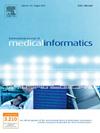Developing a multi-label learning model to predict major adverse cardiovascular events in patients with unstable angina pectoris: A prospective cohort study
IF 4.1
2区 医学
Q2 COMPUTER SCIENCE, INFORMATION SYSTEMS
International Journal of Medical Informatics
Pub Date : 2025-07-02
DOI:10.1016/j.ijmedinf.2025.106037
引用次数: 0
Abstract
Background
Major adverse cardiovascular events (MACE) represent critical endpoints in cardiovascular research. The occurrence of MACE in patients with unstable angina pectoris (UAP) exhibits multidimensional complexity. We employed multi-label learning (MLL) models to concurrently predict five distinct types of MACE.
Methods
This prospective observational cohort study analysed the 978 UAP patients from the Second Affiliated Hospital of Shanxi Medical University (Taiyuan, China) between July 1, 2017, and June 30, 2019. Three-year follow-up endpoints encompassed all-cause death, heart failure, stroke, myocardial infarction, and revascularization. We utilized ReliefF for Multi-label Feature Selection (RFML), Mutual Information-based Feature Selection (MIFS), and Scalable Criteria for Large label Set (SCLS) to identify significant prognostic variables. Nineteen MLL models were implemented, including Binary Relevance (BR), Classifier Chains (CC), Label Powerset (LP), Random k-Labelsets (RAkEL), Multi-label k-Nearest Neighbor, Twin Support Vector Machine to Multi-label Learning, and Wrapping multi-label learning with label-specific features generation. BR, CC, LP, and RAkEL models were constructed using four base classifiers: Decision Tree, Random Forest, Extreme Gradient Boosting, and Light Gradient Boosting Machine. Performance evaluation incorporated 12 different metrics.
Results
The RFML, MIFS, and SCLS respectively screened 18, 12, and 14 important features, and the MLL prediction performance based on RFML selected features was the best. Among the MLL models, RAkEL with Random Forest as the base classifier demonstrated superior predictive performance, achieving an Accuracy of 0.575 0.022, Precision of 0.646 0.029, Hamming loss of 0.159 0.008, One error of 0.425 0.022, Macro_F1 of 0.719 0.028, Micro_F1 of 0.740 0.011, Macro_AUC of 0.786 0.031, Micro_AUC of 0.806 0.030 and Multi-Brier Score of 0.115 0.035.
Conclusions
The RAkEL model with Random Forest as the base classifier significantly enhanced predictive accuracy for MACE in UAP patients. This approach provides a more comprehensive risk assessment, enabling clinicians to develop personalized treatment strategies and improve patient outcomes.

建立多标签学习模型来预测不稳定心绞痛患者的主要不良心血管事件:一项前瞻性队列研究
主要心血管不良事件(MACE)是心血管研究的关键终点。不稳定型心绞痛(UAP)患者MACE的发生具有多方面的复杂性。我们采用多标签学习(MLL)模型同时预测五种不同类型的MACE。方法本前瞻性观察队列研究分析了2017年7月1日至2019年6月30日山西医科大学第二附属医院978例UAP患者。三年随访终点包括全因死亡、心力衰竭、中风、心肌梗死和血运重建术。我们利用ReliefF进行多标签特征选择(RFML)、互信息特征选择(MIFS)和大标签集可扩展标准(SCLS)来识别重要的预后变量。实现了19个MLL模型,包括二元相关性(BR)、分类器链(CC)、标签动力集(LP)、随机k-标签集(RAkEL)、多标签k-近邻、多标签学习的双支持向量机和基于标签特定特征生成的包装多标签学习。使用决策树、随机森林、极端梯度增强和轻梯度增强机四个基本分类器构建BR、CC、LP和RAkEL模型。绩效评估包括12个不同的指标。结果RFML、MIFS和SCLS分别筛选了18、12和14个重要特征,其中基于RFML选择特征的MLL预测效果最好。在MLL模型中,以Random Forest为基础分类器的RAkEL表现出较好的预测性能,准确率为0.575±0.022,精度为0.646±0.029,Hamming loss为0.159±0.008,One误差为0.425±0.022,Macro_F1为0.719±0.028,Micro_F1为0.740±0.011,Macro_AUC为0.786±0.031,Micro_AUC为0.806±0.030,multibrier Score为0.115±0.035。结论以随机森林为基础分类器的RAkEL模型显著提高了UAP患者MACE的预测准确率。这种方法提供了更全面的风险评估,使临床医生能够制定个性化的治疗策略并改善患者的预后。
本文章由计算机程序翻译,如有差异,请以英文原文为准。
求助全文
约1分钟内获得全文
求助全文
来源期刊

International Journal of Medical Informatics
医学-计算机:信息系统
CiteScore
8.90
自引率
4.10%
发文量
217
审稿时长
42 days
期刊介绍:
International Journal of Medical Informatics provides an international medium for dissemination of original results and interpretative reviews concerning the field of medical informatics. The Journal emphasizes the evaluation of systems in healthcare settings.
The scope of journal covers:
Information systems, including national or international registration systems, hospital information systems, departmental and/or physician''s office systems, document handling systems, electronic medical record systems, standardization, systems integration etc.;
Computer-aided medical decision support systems using heuristic, algorithmic and/or statistical methods as exemplified in decision theory, protocol development, artificial intelligence, etc.
Educational computer based programs pertaining to medical informatics or medicine in general;
Organizational, economic, social, clinical impact, ethical and cost-benefit aspects of IT applications in health care.
 求助内容:
求助内容: 应助结果提醒方式:
应助结果提醒方式:


